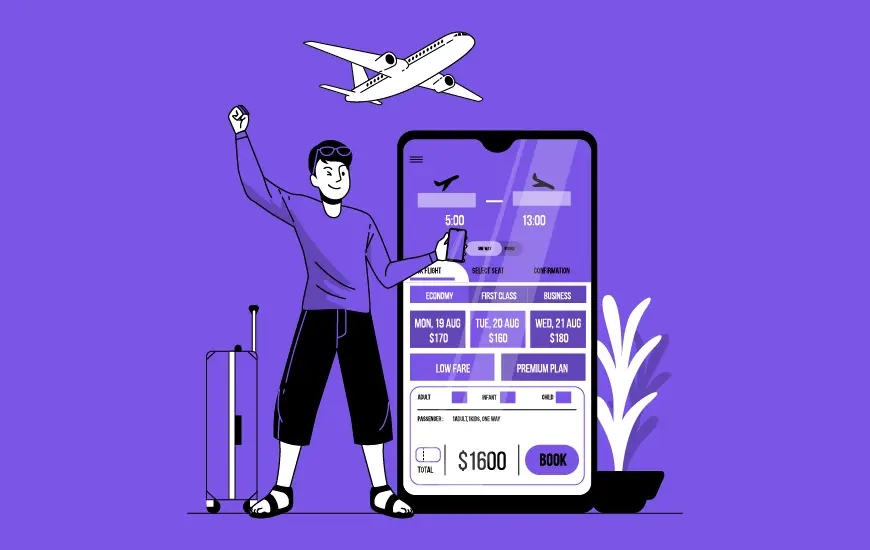- How does the Departure Control System in an airline work?
- Departure control systems for airline passengers
- Departure Control System Benefits for ground handler
- Features of a Departure Control System that help optimize cost
- Check-in and e-ticketing management
- IROPS re-accommodation
- Load manager
- Offline DCS
- Self-service
- Parting words
- FAQs
Imagine a situation where you had to visit five different counters to board a flight – all in a timeframe when you were late to the airport, and the flight was about to depart in 15 minutes. The reason why this scenario can only be a figment of our imagination in most scenarios is because of the presence of departure Control Systems in airline.
Typically, a DCS (Departure Control System) is built to maximize savings in the aviation industry by automating the processing of airport management operations. There are various ways this is done, such as:
- Automated check-in system
- Baggage handling
- Printing of boarding cards
- Boarding
- Generation of the flight’s manifest
- Aircraft checks
- Flight information
While the DCS software works for a range of stakeholders in the airline industry, from travelers to ground handlers, the end goal of this seamless platform is the same – streamlining the process from check-in to departure. In its very basic operative sense, here is how the departure control for Airports works –
How does the Departure Control System in an airline work?
The Departure Control System software typically has two user bases: passengers and ground handling staff. Let us look at the most basic version of how a Departure Control System works for both cohorts.
Departure control systems for airline passengers
The airport operator or company creates a flight on DCS by automatically entering the PNL (Pax name list) or ADL (Pax additions/deletions list). This is an IATA formatted message for transmitting passenger name lists.
Next, passengers arrive at the airport check-in counter before the flight, and then the following operations are managed by the airline Departure Control Systems:
- The passenger’s information is found in the software, if it is not there, a new record gets created. Some Departure Control System software do this activity automatically through an in-built passport reader. In the previous era of aviation management, this process was done manually, but with increased automation, airlines and airport operators save vast amounts of money using a DCS.
- The passenger’s baggage gets weighed and recorded in the software, which then prints a label for every package, and the tags are attached. The DCS is built so that when the baggage weight goes above the limit, it notifies the staff of the extra fee which will be charged. Thus, optimizing the baggage cost in the process.
- Lastly, the airline Departure Control Systems automatically allocate a seat for the passenger, but if they have any special requests, it gets entered into the system at the counter itself. Following this, the boarding pass is issued to the passenger.
This entire system is nowadays managed through a web check-in or an intuitive self-service mobile app. These Departure Control System platforms make it easy for passengers to self-check in, thus avoiding long queues at the airport’s check-in area. On the other hand, this helps save the airline’s cost in handling the passengers while enhancing their experience. Just the same way, blockchain is helping airlines save millions.

Departure Control System Benefits for ground handler
The Departure Control Systems for airline staff takes care of multiple ground-level activities that ensure the timely departure of the flight. At the back of the end-to-end visibility, the ground staff gets through an integrated system that connects the passengers and staff operations, they are able to:
- View the changes made by departure agents or staff in real-time
- Override the check-in mediums
- Manage the automated alerts
- Measure the weight and do balance calculations
- Manually manage the airplane’s load control.
Now that we have looked at the working of the Departure Control System, let us now get down to the factors that make the platform efficient by answering what the main functions of a Departure Control System are.
Features of a Departure Control System that help optimize cost
Local Departure Control Systems, through their multiple integrations, are features designed to automate processes around airline management operations by connecting the check-in zone with load control and aircraft balance. How the system achieves that through a well-thought combination of Departure Control System features.
Check-in and e-ticketing management
The most prominent features of the Departure Control System in airlines that helps with saving costs for airlines both in terms of passenger management and on-premise IT infrastructure is e-ticketing and check-in. By using the functionality, the passengers are able to manage everything from check-in, seat selection, choosing fooding option, and downloading boarding pass on their application.
On the other hand, the ground handling staff are able to manage everything right from passenger check-in status to baggage and airline load capacity, all through one unified platform. Some additional functionalities that are a part of this feature are:
- Resolving ticketing issues after passengers’ re-accommodation
- Verification of international travel documents
- An interface to view seat maps, reprinting the boarding pass, enabled through-check
- Managing in-flight payments and expenses
IROPS re-accommodation
Today’s airlines – the ones witnessing the post-pandemic surge in travelers – work in a high-pressure environment where service disruptions are widespread. However, even though irregular operations are becoming increasingly common, they come with severe business problems ranging from dealing with long lines, increased wait time, and frustrated customers.
Departure Control Systems in Aviation Industry come with an IROPS Re-accommodation feature that notifies and re-accommodate passengers through an integrated system that recognizes passengers through flyer status, fare levels, and Special Service Requests.
Load manager
To increase efficiency and safety in flight, airlines should manage the placement of their loads in a way that reaches equilibrium. Departure Control Systems in airlines come with an in-app weight and balance solution that manages load planning and management through a user-friendly interface. The software offers the carriers an accurate mode of maximizing the aircraft fuel efficiency by identifying the center of gravity.
Backed by automation, these systems make it easy to better aircraft payload utilization. On the other hand, they act as an effective cost-cutting strategy for the airline industry by saving staffing and increasing operational efficiency.
Offline DCS
System outages can create complex scenarios for airport operations. To avoid long lines of frustrated passengers, and extended delays, the departure control for Airport comes with a robust backup functionality that eliminates interruptions and syncs the data back to the host after connectivity is restored.
The offline feature helps the systems to maintain connectivity even after the primary system faces an interruption by linking it to a localized database. It ensures that multiple critical activities like electronic ticket checks, management of passenger manifests, post-flight messages, and notifications around equipment change are managed even when the primary connection is down.
Self-service
Most of the modern-day Departure Control Systems come with a self-service portal for passengers in the form of a mobile app, a web interface, and an in-airport kiosk. Its different modes enable passengers to manage self-check-in, selection of seats, and booking services like meals, insurance, etc. This also helps free up the agents’ time as they can focus on other passengers’ needs without affecting the travel experience for the masses.
Parting words
These different features are a holistic view of how the Departure Control System in airlines is changing to meet the needs of digital-first travelers while saving millions in lost revenue for airlines and airports. The end goal of these features and all the integrations that Departure Control Systems come with is the same on a global scale – bettering passengers’ experience and inculcating cost-effectiveness in the business process.
At Appinventiv, in our role as an aviation software development services provider, our process is drafted to address their pain points and industry-level bottlenecks. Our team of aviation services development experts brainstorms the challenges and builds a Departure Control System in airline that would solve them on a mass level while accommodating a scalability space for growth. Reach our team today for help with a DCS solution.
FAQs
Q. What is a Departure Control System?
A. A DCS is an advanced software solution that helps airlines manage their flight operations by automating various processes. The system enables airlines to have real-time updates and make informed decisions, reducing the risk of delays and improving overall operational efficiency.
Q. How does a Departure Control System work?
A. By automating the various processes involved in flight departures, DCS helps airlines streamline their operations and enhance the passenger experience.
Q. What are the main functions of a Departure Control System?
A. It helps with the management of flight schedules, passenger check-in, baggage tracking, boarding, and flight departures.


Excellence Together

How Digital Twin Technology is Transforming Airline Operations and Safety
The aviation industry, like other sectors, plays a significant role in the economy of every country. Unfortunately, recent years have posed immense challenges for this industry, particularly in 2020 and 2021 during the COVID-19 crisis. Undoubtedly, the airline segment experienced a drastic downturn and incurred an enormous loss of $168 billion. The aviation sector addressed…

Flight Booking App Development Cost: Everything You Need to Know
As per recent reports, there are approximately 6.6 billion active smartphone users globally, making mobile apps ubiquitous in today's digital ecosystem. The exceptional revenue generated by these mobile apps has made them an important aspect of modern business. Interestingly, flight booking apps are also gaining instant popularity in the travel and tourism industry, whose market…











